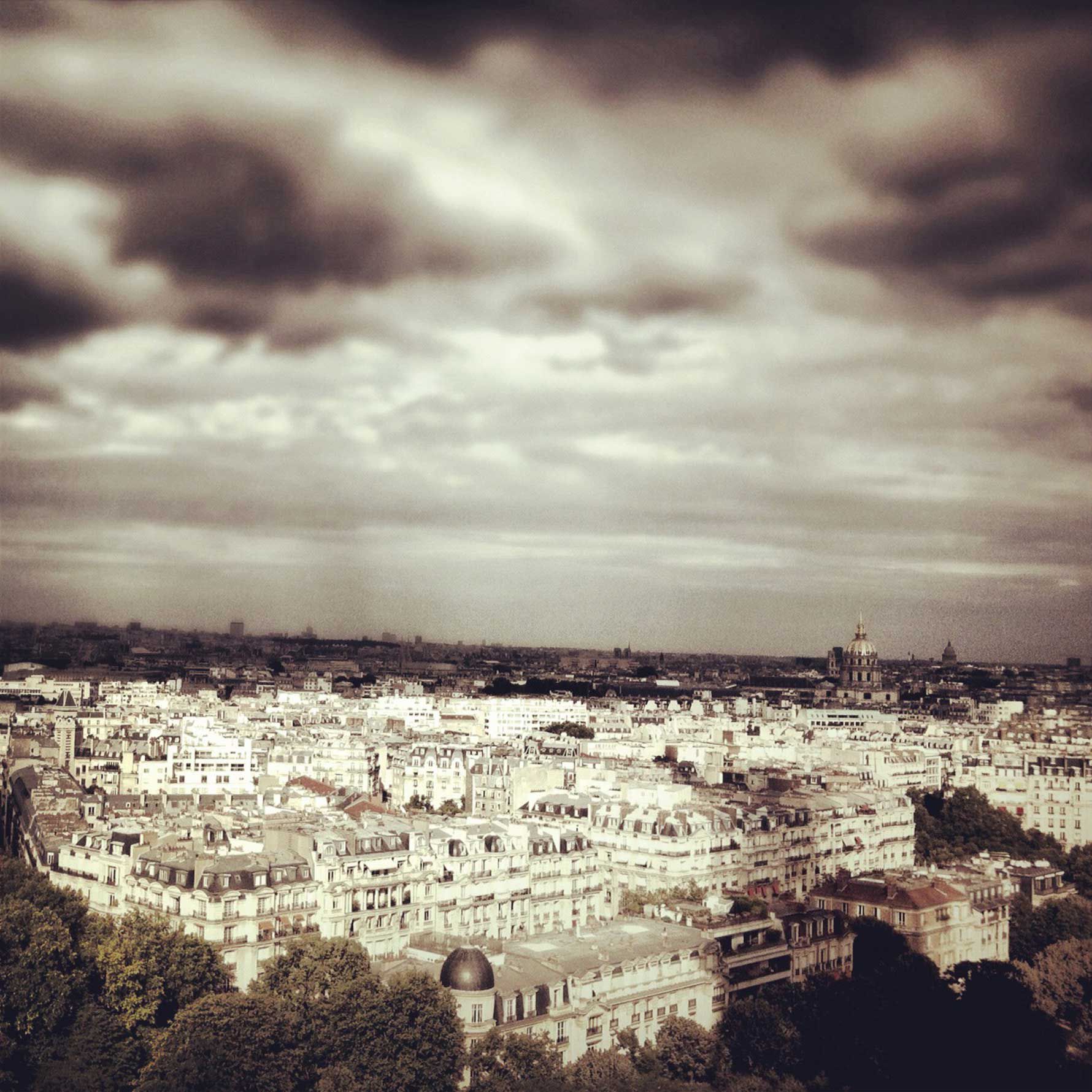The flâneur began in the 6th. Les Deux Magots—coffee—then next door to Café de Flore—hot chocolate. I cut southwest, along the edge of the Luxembourg Gardens, then down Rue de Fleurus. Gertrude Stein’s old apartment appeared suddenly, anonymous save a small plaque. I paused, snapped a photo, and pushed forward with a few purposely circuitous explorations. Onward to Boulevard du Montparnasse for a peek into Le Select, La Coupole, and La Rotonde. The day was young, my legs able, and my step count still low, so I decided to further my perambulations across the city. I swept north-northwest toward the Eiffel Tower. When Les Invalides blocked my way I just smiled, knowing the redirection meant more walking.
More walking meant more steps.
The count was increasing.
This was my life. My life just a few months after getting a Fitbit. I spent evenings hunting Google Maps for walks—new walks, green-lined, meandering walks. Work continued to bring me to new cities, and with each unexplored urban space I felt my chest tighten with excitement; fresh ground to explore, more steps to be had.
Walking is different than biking or driving down a street. Heads stuck in smartphones, we miss the humanity of the scenes we pass. Yet using that same technology we can call up with atomic granularity the time and place of a meeting with a dear friend years back. Sometimes those two spaces collide—technology creating an almost psychic, projected awareness of the here and now.
I bought a Fitbit on a whim. It was spring 2012. I bought it to understand how devices like this worked. If they worked. What it meant, precisely, for them to work. Between JawBone’s Up, Nike’s FuelBand, and now Fitbit, the entrepreneur in me wanted to understand this emergent product space and know how these devices affected awareness.
I assumed our relationship would proceed like this: I’d use the Fitbit for a few weeks, think it was neat, and then forget to wear it. One forgotten day would turn into a week would turn into a month. It would start off as a novelty, devolving quickly into another well-intentioned, dust-covered tech product.
Boy, was I wrong.
There was da Vinci in the 14th century, Thomas Jefferson in the 18th, and a Japanese man named Yoshiro Hatano in the 20th. All obsessed with step counting. Da Vinci’s obsession lived in his mind and in sketches, but Jefferson and Hatano both had pedometers not totally unlike those we know today.
These devices remove much of the friction—analog diligence or overly complex geekery—previously associated with quantifying the self.
In recent decades, the recording process has naturally shifted digital. There is the Quantified Self group, for example, founded in 2008 by Gary Wolf and Kevin Kelly. It’s an über-geeky collection of “users and tool makers who share an interest in self knowledge through self-tracking.” Members worldwide meet regularly to discuss their varied and evolving biometric methodologies.
Fitbit and FuelBand are direct descendants of this alpha-geek space. These emergent devices, if not the first mass-market attempt at quantified products, are certainly the first launched within holistic ecosystems. Which is to say, they connect to Facebook and have well-designed interfaces and systems, making data collection and exploration effortless. They remove much of the friction—analog diligence or overly complex geekery—previously associated with quantifying the self. In doing so, they take the data mind—once shared only between the capable few—and confer it upon us all.
And once had, the data mind is hard to shake.
As work brought me to New York City, Milan, and New Haven, I found myself skipping the subway, shooing away taxis. The summer’s heat was damp and dogged but it didn’t matter—I was a man with steps to acquire.
To my surprise, that initial feeling of “neat” never wore off. Each day I dutifully clipped on the Fitbit. Correspondingly, each day I felt my awareness grow. “How should I move through the city?” it continuously forced me to ask myself. And later, looking at the data, I was able to relive those decisions.
Active for one person is inactive for another. The only way to understand your definition is to give it personal form. One way to make real such abstractions is to ground them in a number. Any number. Steps work well.
“What kind of day was today?” you ask. The steps answer.
You learn to suss out the qualitative feeling of worn comfort after a 20,000-step day, and know the anxiety wrought by an idle 5,000-step day.
There is pleasure to be found in these connections—a simple number, your mind, your body. A nourishing shift in awareness.
Through all of this walking I think of a hologram. Past the cafés of Paris and the bars of Milan, the secretly famous pizza joints of New Haven, and alongside dear, frizzy-haired companions in the East Village, I see this hologram. Like in Star Wars, a fuzzy projection bearing a message from another place and time.
I think of our check-ins, our food photos, our tagged friends. I think of our steps, our Fuel Points. I think of the myriad and nearly endless streams of data—data now actively collected but becoming increasingly passive. I think of all this and I can’t help but see a hologram projected somewhere off in the distance. A reconstitution of something, someone, miles away, years out.
Who is that hologram?
Hard to the west of Palo Alto are mountains. One day I climbed them and that night—Lord help me—I looked at my Fitbit. It was 9 p.m. and the device told me I was at 96 flights of stairs.
I scrambled up and down their rear staircase four times. Each flight I checked the Fitbit, making sure the climbs were properly recorded. The staff eyed me suspiciously.
There was no question in my mind; I had to even the number out. The only problem: Palo Alto is flat.
Thinking fast—there was no time to spare, as the count would reset at midnight—I dashed to the only set of steps I could think of: the Mexican restaurant Reposado. I snuck into the back and scrambled up and down their rear staircase four times. Each flight I checked the Fitbit, making sure the climbs were properly recorded. The staff eyed me suspiciously.
Crazy? Absolutely. I walked across town and ran up and down a flight of stairs four times. I ran up and down to make sure a pinkie-sized, gummy, black LED screen read “100.” I know I wouldn’t have done it otherwise.
Give yourself up to Fitbit. Give yourself up and find pleasure in these strange places. There’s the pinch of excitement when you realize your meeting is on the sixth floor, not the third, and the elevator is broken. Cross-town meetings that might normally annoy instead delight—that’s gotta be a good 6,000 steps to SoHo, you think to yourself, simultaneously calculating in your head the effect it will have on your weekly average.
There was a time when a man died and all that remained were boxes and file cabinets. Tax returns, receipts for record players, letters from children long grown, yearbooks, worn shoes. There was the smell, the touch of cloth. The understanding, perhaps, of how that person lived. However thin that understanding may have been, it was there, embedded in their data, their stuff. A physical remainder, massed together to sketch the edges of a life.

I can’t help but see an element of self-preservation amid our data collection. Preservation embedded deep within our check-ins, our food photos, our tracked steps and mapped run routes. We are collecting like never before.
We used to collect privately. The physical possessions one owns when one dies constitutes, perhaps, an idealization of the self. Those possessions, however, have always been unnetworked. And they were limited by physics; you could only collect so much. Closets filled, things decayed, people moved, treasures were thrown away.
Now the collection is boundless. The space near infinite. Every single item collected is plugged into the network. And so that self—that idealization—suddenly flows fast and far. It touches other selfs, other idealizations. It can be reconstituted by data mappers.
What a strange thing to think: It can be reconstituted by data mappers. But it’s true.
It’s no longer just the edges of a life, a general amassed physicality. It’s the millimeter precision of runs, the numbers of times “Hey Jude” was played, the minutes spent reading Harry Potter, the version-controlled genesis of an essay.
How specific and formful our collections—these collections that constitute our selves—have become. Still not entirely whole, but closer than they’ve ever been. We play them back—literally, scrolling out timelines. A life of thoughts, granular GPS, and time-coded data. Holograms of ourselves, transparent and broken, from another time and place. They skip like a worn record, or a dusty movie reel, with pieces missing here and there. But they are us, however scratchy, and their resolution increases daily.
So there I was: Paris. A pitch-perfect early summer afternoon.
Standing outside my hotel, sun high in the cerulean sky, I decided then to shadow Hemingway across that gorgeous city, to walk to those back streets and farther, to the Eiffel Tower. What else could a data mind do?
By the time I reached the tower’s base, my step count was surely off the charts. There were two ways up: a long line to the elevator, or no wait for the stairs. I happily paid the fee and bounded up the iron stairs with joyful deliberation, lest they not be counted.
I reached the first stage of the tower and then the second. And finally took an elevator—the only option—to the top. Oh, the joy I felt looking back over that city.
Staring out, I traced my walk from so far above. I thought of the staccato data at the beginning of my adventure as I flitted between cafes, stopping for coffee and hot chocolate. The soft lull in the data as I lingered in front of Stein’s apartment. The explosive push to the base of the tower—a leg of my activity graph punctuated by only a small dip as I stopped to buy water. And finally those stairs—all the stairs climbing up the tower; I was certain I had beaten my Reposado record.
I thought of the aggregate—a small corner of my projected hologram. How I would look back on my total data and today would explode out as an outlier and I would remember and replay the walk in granular detail.
Curious as to what the actual numbers were, I reached into my right pocket to check.
Emptiness.
Emptiness followed by dread.
Dread followed by denial.
I looked in the other pocket. I looked in my bag. And then I remembered, with dull thud to the gut—I changed trousers before leaving my room. The Fitbit was back at the hotel, clipped to my jeans, motionless, recording nothing.
That afternoon, looking up from below, you’d have seen a man’s heart sink off the tower. All of the lost data: It tore at the preservationist within. My hologram rendered somehow less complete. A broken stream in the data mind.
Part of me wanted to cab it back to the hotel. Cab it back and clip on the Fitbit and do the walk again. All of it. Mirrored and remapped. Climb the Eiffel steps once more. Ground it. Make it real in the ether. But then I realized how silly that was and instead, I leaned back.
Smiling, I looked out over a Paris glowing golden—caught in a long summer twilight—and enjoyed the day for what it was: a beautiful walk, existing only in my mind, to be forgotten, unrecorded and fleeting, just as it’s always been.


